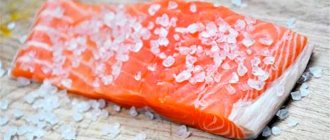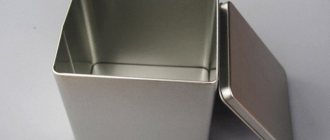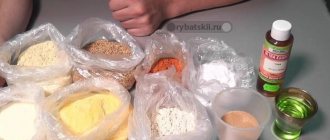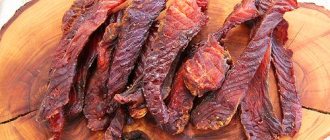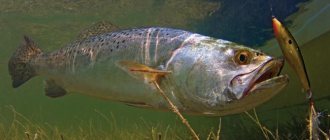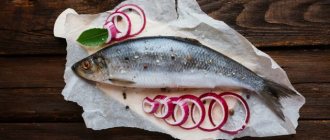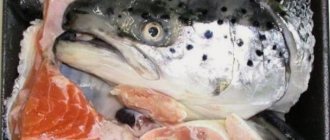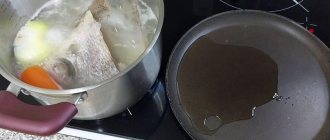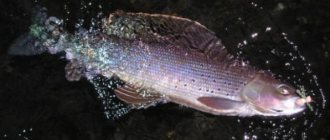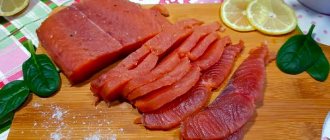Drying stages
Drying fish at home has been around for a long time. The process removes moisture and increases shelf life. Various dehydrators are suitable for this.
Fish dehydrators
There are many ways to organize the process, but in factories and at home there are 3 simple stages:
- pickling;
- soaking;
- drying.
Drying fish or meat is easy step by step. However, it is necessary to understand each stage of drying. You can't make mistakes. The fish will begin to disappear and rot. It will not be possible to correct the situation later.
Salinization
It is impossible to properly dry fish without careful selection of salt. Coarse salt is excellent for this process. It retains moisture better, creating maximum dehydration. Fine grinding will not be able to cope with such a task. The fish meat will remain moist.
Before salting, let's look at 3 important questions. They concern:
- fish size;
- fat content;
- removal of intestines.
Fishermen recommend drying small fish. Large representatives are more difficult to dry. Pike, roach, chebak, rotan, bream, white bream, perch, yellow striper, and roach are excellent choices. Sometimes crucian carp, carp, flounder, smelt, rudd, silver carp, grayling, tuna, shamaika, cape, catfish, taranka, sabrefish, and bluefish are also dried.
Salting fish
If the fish is large, then before drying and salting it is necessary to make a horizontal cut along the back from head to tail - or the product will turn out to be raw. Dryness will not happen either in an air fryer or in a gas or electric oven.
Many also advise not to use excessively fatty fish. However, there is no fundamental difference.
The situation with the removal of intestines is ambiguous. Some people recommend making an incision along the belly and removing all the insides (guts, caviar) with your hands. Others advise abandoning this stage. Removing the entrails has 2 advantages:
- with an open belly, the fish dries out faster;
- the intestines will be bitter and can spoil the taste.
Drying fish at home does not involve first removing the head or tail. The product must be processed as a whole. It is important to preserve the scales; they cannot be peeled off.
Before salting, fish should be washed under running water. Then it is advisable to place the product on a paper towel. The material will absorb excess liquid. You should not salt wet fish.
You need to pour a little coarse salt onto the bottom of a basin or other dish and lay the first layer. Fishermen recommend laying out larger carcasses first. After laying out the first layer, you need to pour salt again and place the second one. However, it must be laid strictly perpendicular to the first.
The scheme must be used before the laying out process is completed.
Then you need to sprinkle the semi-finished product with vinegar. Some recipes also recommend that fishermen spray a small amount of this liquid directly onto the fish itself. Using vinegar is the easiest way to repel flies. In principle, they will not fly up. Sometimes insects even leave their larvae in the semi-finished product.
The last stage is the installation of oppression. It is enough to place a wide plate on the carcasses and place a jar filled with water on top. The pickling needs to be refrigerated for 3 days.
How to salt fish
Some recipes recommend using sugar along with salt. Dried fish will have a slightly sweet taste. “Dessert” is not for everybody.
An important issue is the choice of the amount of salt. The answer to this depends on personal preferences. If you like tough and firm fish, then you need to use a lot of salt. The product is perfect as a kind of beer snack.
Soaking
The container with the semi-finished product must be removed from the refrigerator (some people store the product in the freezer), rinsed under running water and placed in a basin. Then you need to start soaking. To do this, you need to fill the basin with water and immerse the fish. Typically, the entire process of removing excess salt takes no more than 3 hours. However, you should not focus solely on time. The fish should lie until the tails begin to float.
Drying
Now all that remains is to hang the fish and put it in the sun. To protect against rainy weather, the semi-finished product can additionally be placed under a canopy. Drying time – 2-3 days. It is necessary to cover the product with gauze or mesh. This will get rid of flies and other flying insects and prevent the appearance of maggots. They will not sit on the product. This method of protection is the simplest. There is no need to come up with additional devices.
Drying fish
You can dry fish at home in the summer using the head or tail. The result depends on the drying method. When the fish's body is secured by the tail, excess liquid will flow down and exit through the gills and mouth. The product will be saltier.
If you put paper clips through the eyes and hang the fish by the head, much less liquid will drip. More fat will remain inside the fish. The meat will be moist.
Before choosing a method that allows you to properly dry fish at home, you should understand the taste. Fishermen in the instructions note the importance of choosing the drying time. If a person does not want to put it off and wants to get the desired result quickly, then the fish should be kept for 2-3 days. It will become dry.
However, dried fish can also be cooked in a similar mode. You need to hang the fish immediately for 4-5 days.
Have questions? Ask them to an expert!
Leonid Grachev
Fisherman with a lot of knowledge and experience
Ask a Question
How to dry fish in the summer at home: preparation steps
The drying process is characterized by the presence of certain stages that are carried out in the right order. So:
- Salting fish. Any container is suitable for this, but not metal. The fish is sprinkled with salt and then filled with saline solution. After this, the fish is placed in a cold place.
- Washing and soaking fish. Washing and then soaking is carried out in fresh water. The duration of the process depends on the duration of salting.
- Drying process. It is carried out in natural conditions, although you can use any devices.
How to dry fish at home
Summer salting methods
For the salting process, you only need salt and a container. It is better not to use dishes for non-food products. The most important thing is that its volume allows you to salt the required amount of fish. It is better to use coarse salt, which dissolves slowly, removing excess moisture from the fish. Fine salt speeds up the salting process without dehydrating the fish.
Dry salting
This salting method is more suitable for drying carcasses weighing 1 kilogram or more.
The technology is as follows:
- The fish carcass is freed from the entrails by making an incision along the back, after which the fish is cleaned with a rag.
- The fish inside is salted generously, but not very much.
- Fish carcasses are placed in containers in rows, and a cloth should be placed at the bottom of the container. The fish is laid out head to tail and belly up.
- After this, the fish is salted again. For 10 kilograms of fish you will need up to one and a half kilograms of salt.
After the salting process, the fish is covered tightly with a lid, and a heavy object (pressure) is placed on top of the lid.
On a note! The presence of oppression helps prevent the appearance of air bubbles in which harmful bacteria can develop. As a result of the applied pressure, the density of the meat increases.
The fish is salted for 5-10 days. During the salting process, juice is released, which should drain through the cracks at the bottom of the container. In this regard, the process is called “dry” salting.
If small fish is salted, then the insides do not need to be removed. In this case, a small fish is laid out tightly one to one on a cloth, after which it is sprinkled with salt and wrapped in the same cloth. You need to put a weight on top. The juice that appears as a result of salting flows out through the fabric.
Wet method
If the fish is small, then it is better to use the wet method. Fish such as roach, perch or bream are salted in the following way:
- First you need to take a dish and pour salt on its bottom, then the fish fits into this dish quite tightly.
- Having laid out the first layer, the fish is sprinkled with salt, after which subsequent layers are laid out, sprinkling each layer with salt, including the top layer. For 10 kilograms of fish you will need about 1 kg of salt.
- If you add at least one spoon of sugar to the salt, the taste will be more refined.
- All fish are pressed using oppression (weight).
During the salting process, juice appears, and there is so much juice that it can flow over the edge of the container (unless, of course, the fish container is full). During salting, the fish is placed in a cool place, otherwise the fish may spoil without being fully cooked.
When salting at home, the fish is placed in the refrigerator, and when salting on a hike, you should dig a hole in the ground, covering it with branches. If the fish is not large, then it is enough to keep it for a couple of days, and if the carcasses are large, then they will have to be kept in salt for about a week. The fish can be considered ready if its meat becomes firm, and if you pull it by the head, you can hear a characteristic crunch. If, as a result of the test, these characteristics are not confirmed, then the fish is left in the brine for another day. The brine after salting can be reused, and if it is no longer needed, it is poured out.
Bridle method
Before salting begins, the fish is threaded onto a rope using a needle. In this collected state, the fish is lowered for several days, depending on the size, into brine - brine. For small fish, it is enough to lie in the brine for 2-3 days, and if the fish is large, then an additional salt solution is pumped into their carcasses using a syringe
The salt solution is prepared at the rate of 350 g of salt per 1 liter of water. You can combine freshly prepared brine with the brine of the previous salting or with the brine of purchased spiced herring.
Important rule! If you prepare the brine solution correctly, then a raw egg should not sink in it.
The larger the fish, the longer it should remain in the salt solution. At a temperature of 20 degrees, the fish is salted:
- Within a week, the fish is salted if its weight is more than 1 kilogram.
- If the carcasses weigh no more than 0.5 kilograms, it will take about 2-3 days.
- A small fish like sprat is salted for 1 hour.
The readiness of the fish is determined by longitudinal stretching. If you pull the fish by the head, a crunching sound should appear. If there is no crunch, the fish is not yet ready because the salt has not penetrated to the vertebrae. Well-salted fish does not resist finger pressure. If you press on the back of the fish, a hole should remain.
Once the fish has been properly cooked in the brine, it is removed from the brine and left to rest for several hours. As a result, the salt will be evenly distributed in the fish meat, which will lead to a high-quality result.
HOW TO CORRECTLY DRY FISH AT HOME / ROAC / GRANDFATHER’S METHOD / PRIKHODKO BROTHERS
Soaking
The soaking process is considered equally important, since it is intended to get rid of the saltiness from the outer surface of the meat. Desalination of the upper layers means that dried leather does not absorb moisture during storage, and this increases the shelf life of the product. The duration of soaking depends on the duration of pickling: every day of pickling requires 1 hour of soaking.
Washing the fish from dirt and salt is part of the soaking process. The fish is washed carefully, by hand. It is necessary to ensure that the scales, which serve as protection for the internal tissues, do not fly off.
The fish is soaked in a large container of cold water. After some time, the fish begins to float to the surface, which indicates the result achieved. After drying, it will be lightly salted, and its meat will acquire a transparent amber hue.
Too long a soaking process can ruin it, especially for fatty large fish. As a result of prolonged exposure to water, the outer layer gets wet. In this case, it is recommended to soak it in several approaches, removing the fish for the same duration as it was in the water.
Rules for drying under various conditions
As a result of many years of drying experience, it has been established that fish is cooked most correctly if it is strung on a wire or cord. It is better to hang low-fat fish by stringing it head down on a string. It is better to dry fish such as bream or pike perch, placing them head up, stringing them on a rope, pulling it through the eyes. This is necessary to prevent fat from leaking out of the abdomen. Alternatively, it is permissible to use other devices in the form of hooks, nails or thin rods.
On open air
The most delicious fish is the one that has been dried in the right weather in the open air. As a rule, it is a spring day, with air temperatures ranging from 18-20 degrees. The fish is hung using any devices.
Important point! It is desirable that the fish fit loosely against each other, and their bellies are located outward. If the fish is small enough, like sprat, then it is better to dry it on a horizontally stretched mesh.
If you place the fish in the sun, especially in hot weather, it will either “cook” or begin to disappear before it dries. In addition, a valuable product – fat – will leak out of the fish. The ideal drying process is carried out in the shade or under a canopy. If it is too humid outdoors, it is better to bring the fish indoors.
In a cool cellar
If a person lives in a private house, then he must have a cellar, which is an excellent place for salting fish. In addition, smaller fish can be dried in the cellar, although they are then dried in a warmer place.
As for large fish, when drying under normal conditions, bitterness may develop into it, but when drying in a cellar this will not happen, although this may take up to 3 weeks. Fish dried in the cellar is characterized by the best taste.
On the balcony and loggia
A balcony or loggia, if it is glazed and has opening parts for ventilation, is also suitable for drying fish. Here the fish are protected from both rain and cold. The main thing is to hang the fish so that the leaking fat does not drip onto the floor. As an option, a basin or other container is placed under the fish.
The best option is when the fish is dried in a draft, so the balcony or loggia can be opened even when it is cold outside.
Drying in the attic
As a rule, the attic is a well-ventilated room if it does not contain living or utility rooms. The attic is heated through the roof, but remains cool due to the presence of drafts. Here the fish are reliably protected from direct sunlight and precipitation. The main thing is to make sure that the cats do not get the fish.
Drying in a living room
There are times when, in the absence of other options, you have to dry fish in a room, although the room will inevitably be filled with a specific fishy smell, which many do not like. Although such a product is noticeably inferior in quality to air-dried, its taste remains at an acceptable level. This process can be accelerated by using various heating devices.
On a note! The process speeds up noticeably if you use a fan. If there are not many fish, then it can be placed within the gas stove.
In an electric dryer
To dry fish, you can equip yourself with any type of electric dryer that operates on the convection principle, and the heating must be regulated. You should not set the temperature above 30 degrees, as the fish meat will begin to fall off the bones.
Drying is ensured by the operation of a fan. Drying time is about 2 days. Naturally, a fishy smell will be present in a person’s home, but the quality of the product will be acceptable.
Dried Fish in Astrakhan style. How to properly dry, salt and cure fish. Roach, Perch, Taranka
How long to dry and how to determine readiness?
The process of drying fish depends on both the air temperature and its humidity, including the size of the carcasses. A small fish can be ready in just a couple of days, although in reality this process takes one or two weeks. As for large fish, it can be dried for a month.
The fish should not be overdried, but it is better not to dry it a little, determining its readiness by taste.
If the meat is not dry enough, the fish can be left for a while longer.
- Cured meat is quite transparent, but it is dense and elastic, with a hint of fat.
- There are no signs of salt on the surface of the fish, and the skin is durable and easy to remove.
- This fish has a pleasant aroma that evokes appetite.
After drying, the fish can be eaten immediately, but complete ripening of the meat is possible only after 3-4 weeks. To do this, the fish is wrapped in cloth or parchment and then placed in a cool place. After lying in this state, the fish finally acquires its qualities as a full-fledged food product.
How to get rid of flies
Fish that is dried in the open air attracts many insects, especially wasps and flies, with its aroma. Wasps mainly feed on fish meat, but flies not only feed, but also strive to leave their eggs in the fish meat, after which its larvae - maggots - appear.
Without any problems, you can dry fish in the spring, when there are no insects yet, or in the fall, when they are no longer there. In the summer, it is better to start drying in the evening, then the fish dries out overnight, but in the dark there are practically no insects that would be interested in the fish. It is not so easy to escape from flies or wasps, although the place where the fish is dried can be covered with a fine mesh, and the surface of the fish can be lubricated with oil or a weak solution of vinegar. Many people simply cook the fish outdoors, after drying it indoors.
Drying season
Drying fish at home can be delicious during any season. However, it is necessary to take into account external environmental factors. Without this nuance, it will not be possible to obtain the desired result. The product may smell, and the pickling itself may deteriorate.
Summer
Drying fish at home in summer is easier than in winter, spring or autumn. If the temperature is high, there is no rain and there is no forecast, then you can work directly on the street (for residents of the private sector).
Drying fish in summer
In hot weather, it is important to consider the speed of manipulation. The fish disappear quickly. The rules of action are simple. If we managed to catch something, we begin to dry it. This scheme allows you to avoid damage to the product.
For the most attractive result, drying is best done in the shade. Suitable for this:
- balconies;
- attics;
- sheds;
- basements.
Any room that creates shade will help cope with this task. Some fishermen even prefer to dry their catch in greenhouses. Those who like the product to be as dry as possible like to hang fish in such structures. Naturally, opening hours will have to be adjusted. They are judged not by the amount of time spent, but by the appearance of the fish.
It should not smell, the shade of the scales will change to gray.
If the process takes place indoors, then it is better to create an additional breeze. You can use the same fan. Fish must be protected from insects. In the summer they will start up most actively. You cannot put the semi-finished product in the dryer or thread it and hang it without additional protection from flies. Regardless of the type of drying, you should not leave fish open.
Winter
In winter, salting with special features. There is no need to take the product out into the cold. It's better to work indoors. It is important to monitor the temperature. The thermometer should not fall below 0. Sometimes, to ensure this condition, it is necessary to install additional heating.
In winter, fresh fish can also be dried in an electric oven or electric dryer (some models are only suitable for fruits and vegetables, but there are also universal models). The devices can be used all year round.
Drying fish in an electric oven
With their help, you can dry “trifles” without any problems. However, it is better to first cut large fish into small pieces.
Autumn
You can dry fish in the fall. The rules of action are the same as in winter. You can work in the spring, for example, in March. There is no fundamental difference.
Oliva company news
Sun-dried fish is not only popular, but also one of the healthiest foods, as confirmed by many studies. The benefits of this unique product are also evidenced by the average life expectancy of people living in areas where fish is consumed daily and in large quantities. In Japan alone, the average human life expectancy is 80 years, which is significantly higher than in other countries. What is the uniqueness of this product, what effect does it have on the human body, what types of fish can be used for drying and drying?
What is the difference between dried fish and dried fish?
There is no point in arguing about the popularity of both dried and dried fish. These two dishes can decorate the holiday table and diversify the daily diet, delighting guests and household members with their amazing taste and appetizing aroma.
Sun-dried fish has a number of distinctive characteristics:
- Salted carcasses are used for drying, while both pre-salted and fresh fish are suitable for drying.
- The main difference between dried fish and dried fish is the method of its preparation. Dried fish can only be cooked naturally - by leaving it in the sun for a certain amount of time.
- Fatty fish are used for drying. These varieties are not suitable for drying. For these purposes, only dry types are used.
- As for preparing dried fish, there are two drying methods. The first involves drying the fish naturally, in cool weather, the second involves oven drying at appropriate temperatures.
- Dried fish differs from dried fish in terms of cooking time. The first can be consumed after 3 weeks, the second only after 2 months when dried naturally and after 6 hours when dried in an oven.
- Dried fish can be served immediately, while dried fish, which has not been pre-cooked, requires additional processing.
Composition and calorie content
The composition of dried and dried fish directly depends on its variety. In particular, the content of proteins, fats, carbohydrates, vitamins and other elements changes. The constant components that make up any fish remain:
- calcium;
- phosphorus;
- fluorine;
- omega-3;
- potassium;
- magnesium;
- iron.
The calorie content of dried and dried fish differs significantly from each other. 100 g of dried fish contains on average 275 calories, while the same amount of dried fish contains only 139. However, it is worth considering the fact that this figure may vary depending on the type of fish used for drying and drying.
What are the benefits of dried and dried fish?
The rich composition of dried and dried fish has a beneficial effect on the human body. Regular consumption of these unique products helps:
- Prevent the development of cancer. According to many scientists, omega-3, which is included in any type of fish, can destroy cancer cells, which helps prevent the formation of malignant tumors and other cancers.
- Prevent the development of Alzheimer's disease. Regular consumption of fish in any form helps reduce the risk of developing this serious disease by 30%. This fact has been confirmed by many scientific studies.
- Reduce the risk of developing depressive conditions. Fish contains a large amount of acids, which improve the functioning of the human nervous system and prevent the development of depression.
- Minimize the risk of developing a heart attack. Regular consumption of dried or dried fish can reduce the risk of heart attack by 40%.
- Reduce the risk of stroke. Sun-dried fish, consumed at least 2-3 times every 7 days, reduces the risk of stroke by more than 40%.
- Reduce the risk of fatty plaques forming in blood vessels. The acids that make up fish effectively fight the formation of fatty plaques, which has been proven by British scientists in the course of long-term research.
- Minimize the risk of preterm labor. The substances that make up fish can have a beneficial effect on the body of a pregnant woman, preventing the occurrence of premature labor and other complications.
For children
According to experienced pediatricians, dried and dried fish can be introduced into a child’s daily diet only after he reaches the age of six. By this time, the child’s digestive system will be fully formed and will be able to digest this food product.
Regular consumption of dried and dried fish will help:
- improve the functioning of the immune system;
- prevent vision impairment;
- establish metabolic processes;
- maintain the health of children's teeth;
- strengthen bone tissue;
- prevent the development of anemia;
- improve the functioning of the digestive system;
- prevent the development of thyroid diseases;
- saturate the body with vitamins and other nutrients necessary for normal development.
Despite the many beneficial properties of dried and dried fish, pediatricians recommend that parents consult with their doctor before introducing it into their child’s daily diet. Only a qualified specialist will be able to identify contraindications to its use and adjust the permissible daily intake, which will help prevent the development of serious health problems.
When losing weight
But during a diet, the goal of which is weight loss, it is better to avoid eating dried and dried fish. And it’s not even about calories, but about the large amount of salt that is used during its preparation. Excessive salt consumption can negatively affect the process of weight loss and even cause severe edema.
Harm and contraindications
Doctors advise limiting or even completely abandoning the consumption of dried and dried fish for those people who suffer from:
- from hypertension;
- swelling;
- urological diseases;
- excess weight;
- slow metabolism;
- pancreatitis;
- gastritis;
- gout
Women who are breastfeeding and children under 6 years of age should also limit their consumption of salted fish.
How to select and store dried and dried fish
The beneficial properties of dried and dried fish directly depend on the quality of the product. In order to purchase good quality fish and minimize the risks of poisoning from this product, when purchasing you should pay attention to the following nuances:
- Color. High-quality fish will have an even color. The presence of stains and white deposits indicates a low quality product.
- Density. High-quality salted fish should be firm, but not too hard. This indicates low quality of the product.
- Integrity of scales. If some parts of the fish are missing scales, such a purchase should be abandoned.
- Aroma. The light, marine, slightly salty aroma indicates the high quality of the product.
Having chosen quality fish, it is important to understand how to store it correctly. There are several ways to store dried and dried fish. Most often it is stored at room temperature. In this case, the fish will be suitable for consumption within 70 days.
It is allowed to store such fish in the freezer, in tightly closed containers or vacuum bags. In this case, the shelf life of the product will be 12 months.
Source:
Where to dry
You can dry fish to prevent flies from landing in a variety of household appliances or simply on the street. There are no fundamental differences. Some fishermen claim that natural drying produces more attractive results.
On the balcony
When drying, a natural shadow is created on the balcony. If the process is carried out in winter, it is better to install a heater. Frost will be of no help.
Drying fish on the balcony
In summer, this process has a different feature. A fan needs to be installed. Otherwise, the fishy smell will enter the apartment.
In the oven
To cook fish in the oven, a different technique is used. You need to rub the carcass with salt, pepper and other seasonings. After this, it should be removed under pressure for 48 hours. Then the semi-finished product is washed, laid out on a paper towel (plain newspapers are not suitable) and transferred to the oven.
It’s good if the household appliance has convection. In this mode, the hot air moves not only upward, but also throughout the volume of the cabinet.
Temperature +40 degrees Celsius. The semi-finished product is kept at this heating for 2 hours, taken out and allowed to cool. Then they are put back into a heated cabinet for 3-4 hours.
In the vegetable dryer
There are other nuances when preparing dried fish in a fruit and vegetable dehydrator. You need to focus on the color of the semi-finished product. The finished product will be gray or even black.
To change the taste, you can additionally put various herbs on the bottom of the device.
Cooking time depends on the size of the fish. The capelin is dried for 4 hours; the finished mackerel can be obtained in 10 hours.
In a refrigerator
A refrigerator is also suitable. You need to salt river fish for drying at home according to the specified recipe. Then the soaking procedure is carried out.
Drying fish in the refrigerator
At the final stage, the semi-finished product just needs to be placed in the refrigerator. You should first wrap each carcass in a paper towel.
In the greenhouse
The rules for working in a greenhouse do not differ from the recommendations for the street. It is only important to correctly track the work time. In hot weather, drying is faster.
Under the fan
The fish is dried under a fan in the apartment or on the balcony. The device is necessary to remove unpleasant odors.
Beneficial properties of dried fish and meat
Dry meat tastes good and is healthy for healthy people; it has very high nutritional value. Being complete sources of essential amino acids, dry meat and fish are 100% natural products, without excess amounts of fats harmful to the body.
Dry fish is a source of Omega class polyunsaturated acids, which protect blood vessels from clogging, maintaining their strength and elasticity. It is thanks to Omega 3 that the concentration of cholesterol in the body decreases, and the risk of diseases of the heart, brain, and blood vessels is reduced.
In addition, dry fish contains vitamins A and D, which are necessary for the skin, nails, eyes, hair and human skeleton. Sea fish is especially useful due to its iodine and fluorine content, which are used by the body to nourish the thyroid gland and teeth.
3
Dangerous properties of dried fish and meat
Dry meat and fish should not be consumed by people with gout, as well as people with gastrointestinal disorders, due to the high content of protein and salt in these meat products.
Such products are also contraindicated for people suffering from high blood pressure, due to the property of salt to retain fluid. Dry fish sometimes contains helminths, which can cause helminthic infestations. Therefore, it is advisable to consume only well-dried sea fish in dry form, which practically does not contain worms. Exceptions: ram and herring, which are dangerous not only in dry form, but also in other ways of preparing them.
Tatyana Eliseeva chief editor of the Food+ project
Ask a Question
Rating:
0
/10
Votes: 0
Material usefulness 0
Reliability of information 0
Article design 0
